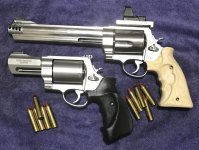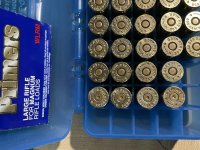Hey guys,
I’ve been reloading smaller loads for awhile. This last year I took on my favorite hand gun the S&W 500. Now I started with 350gn XTP bullet, Starline brass, LRMP, and just starting load data following H110 powder. Round shoots very nice, cases don’t stick but I noticed my primers are getting a little flat and I’m already at the starting load. I’m not going crazy with a roll crimp, just enough to roll and pinch.
I noticed that hodgdon also listed a CFE BLK powder with lots of data for the 500. So I got some, hard part was finding exact cast bullets matching their data, but from a 375 gn cast bullet to a 440 gn cast bullet, there powder charge was pretty close, so I was trying to work up a load for 400gn and 420gn cast bullets I could get my hands on. This is the weird part, at there starting powder charge for a 440gn cast bullet, is 41.6 gn. That filled the case up a lot. I did find I backed it to 41gn and took a measurement, I could load the 420gn cast round to the crimp groove without compression of powder. I made 5 rounds, and tried them today, they shot very well, spent cases fell right out, but I noticed my primers are flat not much but little more than following the exact start load I listed above with H110. My question is can I back the round off a couple gn’s. ? Is that safe to do until I see normal edges of the primer again? Any thoughts would be appreciated!
I’ve been reloading smaller loads for awhile. This last year I took on my favorite hand gun the S&W 500. Now I started with 350gn XTP bullet, Starline brass, LRMP, and just starting load data following H110 powder. Round shoots very nice, cases don’t stick but I noticed my primers are getting a little flat and I’m already at the starting load. I’m not going crazy with a roll crimp, just enough to roll and pinch.
I noticed that hodgdon also listed a CFE BLK powder with lots of data for the 500. So I got some, hard part was finding exact cast bullets matching their data, but from a 375 gn cast bullet to a 440 gn cast bullet, there powder charge was pretty close, so I was trying to work up a load for 400gn and 420gn cast bullets I could get my hands on. This is the weird part, at there starting powder charge for a 440gn cast bullet, is 41.6 gn. That filled the case up a lot. I did find I backed it to 41gn and took a measurement, I could load the 420gn cast round to the crimp groove without compression of powder. I made 5 rounds, and tried them today, they shot very well, spent cases fell right out, but I noticed my primers are flat not much but little more than following the exact start load I listed above with H110. My question is can I back the round off a couple gn’s. ? Is that safe to do until I see normal edges of the primer again? Any thoughts would be appreciated!


